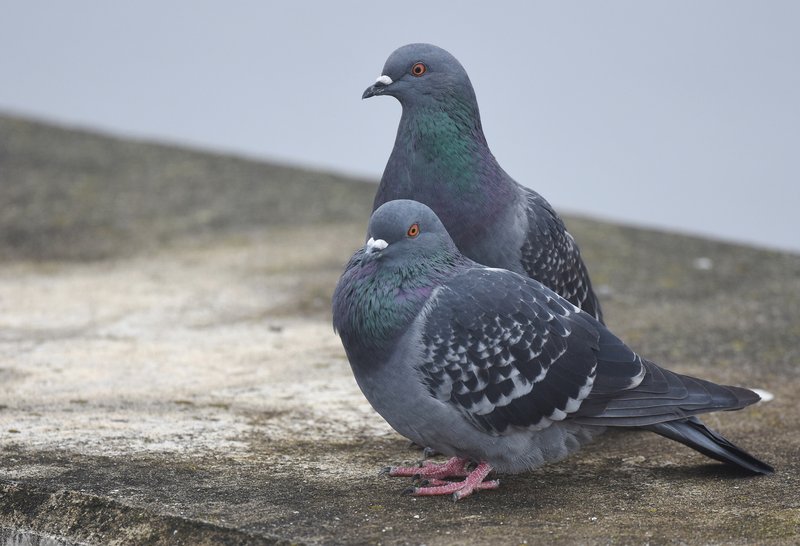
It’s easy to overlook these birds in urban environments, where they thrive amidst our hustle and bustle. But take a moment to appreciate their presence. They’ve become a part of our daily lives, from parks to rooftops, blending seamlessly into our landscapes. So, let’s dive into ten intriguing facts about the rock pigeon that might just change how you look at them.
1. They Have a Rich History
Rock pigeons have been flying around for thousands of years. In fact, they are believed to be domesticated descendants of wild pigeons from the Mediterranean region. These birds were first domesticated by humans over 5,000 years ago! Isn’t that wild? They’ve been used for various purposes through the ages—from carrying messages in wartime to serving as beloved pets.
You might be wondering how they went from wild birds to city dwellers. Well, as humans built cities, rock pigeons found plenty of food and nesting spots among our architecture. They adapted quickly, becoming the urban birds we see today. Their ability to thrive in diverse environments makes them quite remarkable.
2. Exceptional Navigators
Here’s the thing: rock pigeons are known for their incredible navigation skills. You’d be amazed at how they find their way home from places far away. Studies suggest they use a combination of visual cues, the Earth’s magnetic field, and even the position of the sun to guide them.
Imagine being dropped off in an unfamiliar city, and somehow, you could make your way back to your home—without a GPS! That’s what these birds can do. Some researchers believe that pigeons can detect low-frequency sounds and even smell their way home. They might not be able to use a smartphone, but they’ve got their own super navigation skills!
3. A Colorful Variety
You might think that all rock pigeons look the same, but they actually come in a range of colors and patterns. The common ones you see are often gray or bluish with iridescent feathers on their necks. However, they can also be white, black, and even speckled. Some have unique markings that make them quite striking.
This variety comes from their long history of breeding, with both wild and domesticated versions contributing to their colorful coats. If you look closely, you might spot a pigeon with a beautiful blend of hues that catches your eye. It’s like finding hidden gems in an urban landscape!
4. They’re Smart Birds
Honestly, rock pigeons get a bad rap sometimes. Many people think of them as simple-minded birds, but don’t be fooled! They are surprisingly intelligent. Pigeons can solve complex problems and have excellent memories. They can even recognize themselves in mirrors, which is a sign of self-awareness.
In studies, they’ve shown they can learn and remember tasks, distinguishing between different images and even recognizing letters. It’s a bit like a feathered Einstein! Their intelligence helps them adapt to urban life and navigate challenges, making them more resourceful than you might think.
5. Communication Experts
If you’ve ever watched a group of pigeons, you might have noticed their distinct cooing sounds. These little vocalizations are just part of their complex communication system. Pigeons use various calls to convey different messages, like signaling danger, attracting mates, or even just socializing with one another.
It’s fascinating to think of them having their own language, isn’t it? Their ability to ‘talk’ helps them bond and form tight-knit communities. Next time you hear that soft cooing, remember that there’s a conversation happening right in front of you!
6. Rock Pigeons and Their Diet
You probably see pigeons pecking at breadcrumbs or seeds in parks, but their diet is a bit more diverse. Rock pigeons primarily eat seeds, fruits, and grains, but they aren’t picky eaters. In urban areas, they adapt their diets to include leftover human food, which can range from pizza crusts to french fries.
It’s important to note that their ability to forage for food helps them thrive in cities. However, feeding pigeons human junk food isn’t the best idea. A balanced diet keeps them healthy and supports their vibrant lifestyles. Think of it as feeding your friend that healthy smoothie rather than greasy takeout!
7. Breeding and Nesting Habits
Let me explain how rock pigeons handle family life. They are monogamous and typically mate for life, which is quite sweet! When it comes time to nest, they look for sheltered spots—like building ledges or even inside structures. Pigeons prefer to build their nests with twigs, grass, and other materials they can find.
After laying eggs, both parents share responsibilities in raising their chicks. They take turns incubating the eggs and feeding their young with a nutrient-rich substance called “pigeon milk,” which they produce in their crops. Isn’t that an adorable way to care for their little ones?
8. They Have Strong Homing Instincts
You might be surprised to learn that rock pigeons are renowned for their homing instincts—that’s why they were used as messenger birds in the past. Their ability to return home from long distances makes them special in the avian world.
But how do they pull this off? As mentioned earlier, they rely on various cues and their keen sense of direction. Homing pigeons used in races are bred selectively for this strong instinct. It’s pretty remarkable how a simple bird can have such a profound connection to its home.
9. Urban Adaptations
With cities sprawled across the globe, rock pigeons have adapted remarkably to urban environments. They’ve learned to navigate traffic, avoid predators, and find food sources. Consider them as the original city slickers! Their adaptability is key to their survival, and they thrive where few other birds might struggle.
This urban adaptability has led researchers to study them as indicators of environmental health. Their presence can often tell us about the state of our urban ecosystems. So, the next time you pass by a flock, remember they’re not just ordinary birds; they’re adaptive survivors.
10. Conservation and Future
While rock pigeons are common, they still face challenges in urban areas due to habitat loss and pollution. Some people see them as pests, leading to misguided efforts to control their populations. However, they play a significant role in urban ecosystems and deserve our respect.
As a species, rock pigeons remind us of the beauty and resilience of nature, even in our bustling cities. Supporting local conservation efforts can help ensure these birds continue to thrive. After all, a little appreciation for our feathered friends can go a long way in preserving their place within our urban landscapes.
In conclusion, rock pigeons are more than just the birds we see on our streets; they’re layered with history, intelligence, and adaptability. The next time you spot one, take a moment to appreciate their unique qualities—there’s a story behind every flap of their wings!

